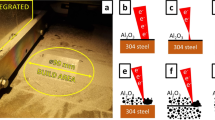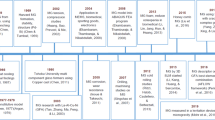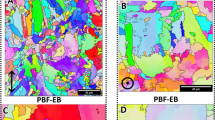Abstract
Selective laser melting (SLM) is recognized for additive manufacturing from metals and alloys. Application of this technique to ceramic materials could also be promising. However, ceramics are brittle and often crack during this process. Silica glass is promising for obtaining crack-free ceramic parts due to its extremely low thermal expansion coefficient. The carried out experiments are elementary steps of SLM. Powder of particles <20 μm is deposited on a thick substrate to form layers of thickness from 100 to 200 μm. The obtained sandwich-like target is scanned with the laser beam of 10.6 μm wavelength. Cracking of silica glass is not observed at laser treatment. The quality of the obtained single beads is very sensitive to the laser power and the scanning velocity. This indicates that consolidation of powder requires a narrow temperature interval. A precise control of laser parameters is necessary to maintain the temperature within this range. Such control can be difficult to attain for industrial SLM machines. The theoretical analysis of consolidation kinetics shows that the best solution of this problem would be using powder with smaller particle size. The beads of consolidated powder can be superposed to form a uniform layer on the substrate. The lower is the thickness of the powder layer, the better is the quality of the consolidated layer. This is because of more uniform heating of finer layers by laser.
Similar content being viewed by others
References
Li Q, Danlos Y, Song B, Zhang B, Yin S, Liao H (2015) Effect of high-temperature preheating on the selective laser melting of yttria-stabilized zirconia ceramic. J Mater Process Technol 222:61–74
Maruo H, Miyamoto I, Inoue Y, Arata Y (1982) CO2 laser welding of ceramics. J Jpn Weld Soc 51:182–189
Ghosh S, Choi J (2006) Modeling and experimental verification of transient/residual stresses and microstructure formation in multi-layer laser aided DMD process. J Heat Transf 128:662–679
Gusarov AV, Pavlov M, Smurov I (2011) Residual stresses at laser surface remelting and additive manufacturing. Phys Procedia 12:248–253
Ryzhkov EV, Pavlov MD, Gusarov AV, Artemenko YuA, Vasiltsov VV (2012) Analysis of cracking at selective laser melting of ceramics. In: Sudarshan TS, Jeandin M, Firdirici V (ed) Proc 26 Int Conf Surface Modification Technologies, Lyon, pp 535–546
Gusarov AV, Malakhova-Ziablova IS, Pavlov MD (2013) Thermoelastic residual stresses and deformations at laser treatment. Phys Procedia 41:889–896
Tang HH, Liu FH, Lin WH (2006) Rapid prototyping machine based on ceramic laser fusion. Int J Adv Manuf Technol 30:687–692
Yen HC, Tang HH (2012) Study on direct fabrication of ceramic shell mold with slurry-based ceramic laser fusion and ceramic laser sintering. Int J Adv Manuf Technol 60:1009–1015
Wilkes J, Wissenbach K (2007) Rapid manufacturing of ceramic components by selective laser melting. In: Proc LIM, Munich, pp 207–211
Hagedorn Y-C, Wilkes J, Meiners W, Wissenbach K, Poprawe R (2010) Net shaped high performance oxide ceramic parts by selective laser melting. Phys Procedia 5:587–94
Wilkes J, Hagedorn YC, Meiners W, Wissenbach K (2013) Additive manufacturing of ZrO2-Al2O3 ceramic components by selective laser melting. Rapid Prototyp J 19:51–57
Deckers J, Meyers S, Kruth JP, Vleugels J (2014) Direct selective laser sintering/melting of high density alumina powder layers at elevated temperatures. Phys Procedia 56:117–124
Wang W, Ma S, Fuh JYH, Lu L, Liu Y (2013) Processing and characterization of laser-sintered Al2O3/ZrO2/SiO2. Int J Adv Manuf Technol 68:2565–2569
Zocca A, Colombo P, Gunster J, Muhler T, Heinrich JG (2013) Selective laser densification of lithium aluminosilicate glass ceramic tapes. Appl Surf Sci 265:610–614
Fateri M, Gebhardt A, Thuemmler S, Thurn L (2014) Experimental investigation on selective laser melting of glass. Phys Procedia 56:357–364
Ciurana J, Hernandez L, Delgado J (2013) Influence of process parameters on surface quality of CoCrMo powder material. Int J Adv Manuf Technol 68:1103–1110
Pupo Y, Monroy KP, Ciurana J (2015) Energy density analysis on single tracks formed by selective laser melting with CoCrMo produced by selective laser melting. Int J Adv Manuf Technol. doi:10.1007/s00170-015-7040-3
Khmyrov RS, Grigoriev SN, Okunkova AA, Gusarov AV (2014) On the possibility of selective laser melting of quartz glass. Phys Procedia 56:345–56
Wray KL, Connolly TJ (1959) Thermal conductivity of clear fused silica at high temperatures. J Appl Phys 30:1702–1704
Sosman RB (1927) The Properties of Silica: An introduction to the properties of substances in the solid non-conducting state. American Chemical Society Monograph Series 37, New York, Chemical Catalog Co
Grigoriev IS, Meilikhov EZ (1991) Physical quantities. Handbook. Energoatomizdat, Moscow
Kingery WD (1960) Introduction to ceramics. Wiley, New York
Richter F (2006) Upsetting and Viscoelasticity of Vitreous SiO2: Experiments, Interpretation and Simulation. Thesis. Berlin
Gusarov AV, Kovalev EP (2009) Model of thermal conductivity in powder beds. Phys Rev B 80:024202
Rombouts M, Froyen L, Gusarov AV, Bentefour EH, Glorieux C (2005) Photopyroelectric measurement of thermal conductivity of metallic powders. J Appl Phys 97:024905
Gray DE (1972) American Institute of Physics handbook. McGrawHill, New York
Author information
Authors and Affiliations
Corresponding author
Rights and permissions
About this article
Cite this article
Khmyrov, R.S., Protasov, C.E., Grigoriev, S.N. et al. Crack-free selective laser melting of silica glass: single beads and monolayers on the substrate of the same material. Int J Adv Manuf Technol 85, 1461–1469 (2016). https://doi.org/10.1007/s00170-015-8051-9
Received:
Accepted:
Published:
Issue Date:
DOI: https://doi.org/10.1007/s00170-015-8051-9




